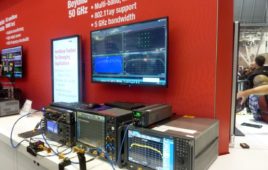Federated Wireless announced two milestones in the effort to commercialize use of the 3.5 GHz band, including the submission of a proposal to the FCC for Initial Commercial Deployments on the Citizens Broadband Radio Service (CBRS) band with 15 industry customers.
“There’s no more waiting—the vision that we began for the industry five years ago has become a reality—shared spectrum commercialization has begun, and at a far greater scale and scope than we all anticipated at this stage. Businesses can now access shared spectrum to not only introduce new services and create new businesses models, but solve decades old challenges, such as improving wireless connectivity indoors and outdoors, and closing the digital divide,” says Iyad Tarazi, president and CEO at Federated Wireless, in a statement. “Today’s announcements break down the barriers to shared spectrum—from commercial enablement, to training, to the ongoing support required for success. Now the fun part starts, and we look forward to working with our partners and customers as we enter this transformative time for the wireless industry as a whole.”
The FCC proposal includes participation from 15 of the industry’s wireless operators, cable operators, tower companies, Managed Service Providers, and CBRS Device vendors, including American Tower, Arris, Charter Communications, and ExteNet Systems. It’s also on a nationwide scale with nearly 16,000 deployment sites in 47 states and Washington, D.C.
Federated Wireless says the proposal demonstrates widespread adoption by leaders across the wireless ecosystem in the fourth quarter of 2018, and signals readiness for the commercial use of the band immediately.
The proposal also includes more than 80 rural fixed wireless carriers and 15 CBSD vendors including, Ericsson and Ruckus Networks, that are integrated with Federated Wireless’ products and ready with commercial equipment for CBRS.
The company said it involves a brand range of use cases including 5G, advanced LTE, cable wireless solutions, fixed and mobile networks, enterprise Private-LTE, and managed services, as well as landmark major venue locations for sports and entertainment.
“CBRS is turning out to be a diverse sandbox, with participation by players in at least five different business models: mobile operators, MVNOs, neutral host players, Private-LTE, and fixed wireless access. To facilitate more innovation in multiple market sectors, it’s great to see the scope and scale behind Federated Wireless’ launch,” says Joe Madden, principal analyst and president of Mobile Experts, in a statement. “Compared with the initial small cell launches by mobile operators, this is gigantic.”
CPI Training Program
The second milestone is Federated Wireless’ introduction of a new training program for Certified Profession Installers (CPI) of Citizens Broadband Radio Service Devices (CBSD), which address the FCC’s initial commercial deployment rules that require all CBSDs be installed by a certified professional installer. The Wireless Innovation Forum reviewed and certified the program modules and curriculum in accordance with FCC mandates.
The program is going to be available at the end of October, when the FCC is expected to approve the Initial Commercial Deployment proposals.
Federated Wireless said it’s also on track to complete its dedicated nationwide ESC network in the first quarter of 2019, enabling full access to the entire 150 MHz of 3.5 GHz spectrum.
The move comes on the same day as a number of other CBRS-related announcements. AT&T announced it selected Samsung and CommScope to provide the carrier with its 5G-ready CBRS network solution. CommScope was chosen as the Spectrum Access System (SAS) provider, while Samsung will provide CBRS compliant radios and base station equipment.
Ruckus Networks, an Arris company, meanwhile, announced it’s the first vendor to achieve FCC certification for CBRS and plans to trial 3.5 GHz LTE access points in Illinois with Pavlov Media. The certification covers Ruckus’ portfolio of 3.5 GHz access points under its OpenG brand.


